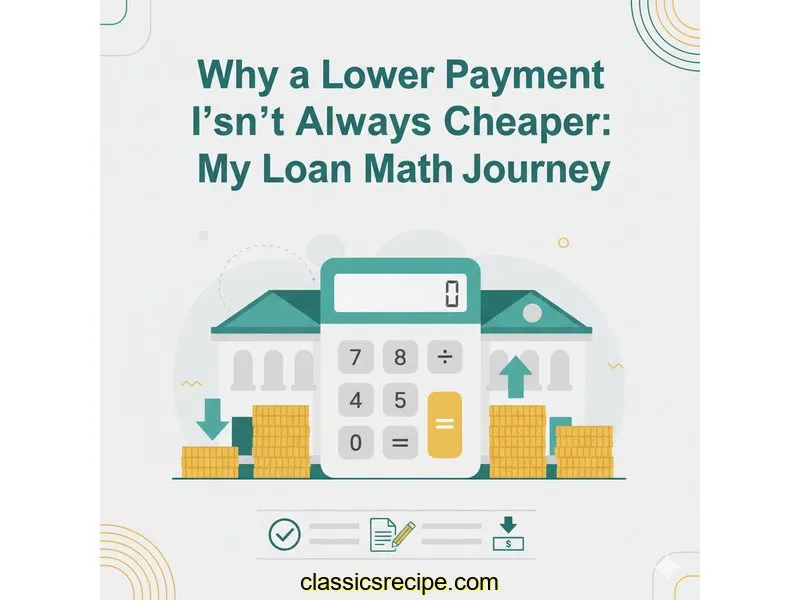
Auto Loan Calculator
Calculate payments over the life of your Loan
Home Blog Privacy Terms About Contact
Calculate payments over the life of your Loan
Home Blog Privacy Terms About ContactPublished on October 14, 2025

It all started with a simple, offhand comment. I was chatting with my cousin about a purchase he was considering, and he mentioned he was planning to take a longer-term loan to get a "really low monthly payment." Someone else in the room immediately chimed in, saying that was a terrible idea and would cost him more. The conversation moved on, but that little contradiction stuck with me.
How could a lower payment possibly cost more? In my mind, lower always meant better, cheaper. It felt like a riddle. This wasn't about me needing a loan or making a big financial decision; it was about pure curiosity. The math just didn't seem to add up in my head, and I felt a pressing need to understand why. What hidden calculation was I missing?
So, I did what most of us do: I opened my laptop and started searching for online loan calculators. My goal was simple: to figure out the mechanics behind this puzzle. I wasn't looking for financial advice; I just wanted to see the numbers move and understand the relationship between them. This is just me sharing that journey of understanding how the calculations actually work.
I plugged in some random numbers, feeling like I was on the verge of a breakthrough. But my initial fumbling only made me more confused. The calculators were spitting out numbers, but I didn't understand the story they were trying to tell. I could see the monthly payments change, but the "why" was still a complete mystery.
My first attempt to solve this puzzle was, in retrospect, completely wrong. I decided to create a hypothetical scenario. Let's say I needed to borrow $18,350. I found a calculator and plugged that number in, along with a hypothetical interest rate of 7.2%. The real magic, I thought, was in the "Loan Term" box.
First, I entered a term of 48 months (4 years). The calculator returned a monthly payment of about $441.76. "Okay," I thought, "that's my baseline."
Then, I changed only one thing: the loan term. I increased it to 72 months (6 years), just like my cousin had suggested doing. The calculator updated, showing a new monthly payment of around $314.17. My immediate reaction was a sense of validation. The payment was over $127 lower! It seemed so obvious—the longer loan was the "better deal" because it was more manageable each month.
I spent a good ten minutes just playing with the term, watching the monthly payment number go up and down. I was so focused on that one field that I completely ignored everything else on the page. There were other outputs, like "Total Principal Paid," "Total Interest Paid," and even a button for an "Amortization Schedule." To me, they were just clutter, distracting from the main event: the monthly payment.
My mistake was that I was treating the loan like a subscription service. I thought the only thing that mattered was the monthly cost. I wasn't thinking about the total picture. The frustration set in when I tried to explain my "discovery" to a friend, who simply asked, "But what's the total amount you'd pay back on both?" I had no answer. I had only looked at one piece of the puzzle and assumed I saw the whole picture.

That one question from my friend—"what's the total amount you'd pay back?"—was the key that unlocked everything. It was so simple, yet I had completely overlooked it. I felt a little foolish, but mostly, I was determined to find the answer. I went back to my calculator results, but this time with a new mission.
Instead of relying on the calculator's other fields, I decided to do the math myself. It felt more tangible. For the first scenario, the 48-month loan, I took the monthly payment and multiplied it by the number of payments:
$441.76 (Monthly Payment) x 48 (Months) = $21,204.48 (Total Repaid)
Then I did the same for the second scenario, the 72-month loan:
$314.17 (Monthly Payment) x 72 (Months) = $22,620.24 (Total Repaid)
I stared at those two numbers for a solid minute. There it was, in plain sight. The loan with the lower monthly payment would result in me paying back $1,415.76 more in total. It was the complete opposite of what my intuition had told me. That was the moment everything clicked. The calculator wasn't just a tool for finding a monthly payment; it was a tool for understanding the entire financial journey of a loan.
Armed with my new understanding, I went back to the online calculator and looked for the numbers I had just calculated manually. And there it was, clear as day: the "Total Interest Paid" field. For my 48-month scenario, it showed $2,854.48. For the 72-month scenario, it showed $4,270.24. It was the exact difference I had calculated. I had been ignoring the most important output on the entire page.
This led me down another path: understanding why more time equaled more interest. I learned that interest is calculated on the outstanding balance. With a longer loan, the principal balance decreases more slowly. This means that for a greater number of months, you are paying interest on a larger balance compared to a shorter-term loan. Each of those 24 extra payments in my 72-month scenario included an interest charge, and those charges added up significantly over time.
To make sure this wasn't a fluke, I ran a completely different scenario. I imagined a smaller loan of $12,000 at 6.5% interest. First, I calculated it for 36 months, which gave a monthly payment of about $368 and total interest of around $1,248. Then, I changed the term to 60 months. The payment dropped to about $235, but the total interest jumped to over $2,100. The principle held true. My understanding was solidifying.
This whole experience was incredibly eye-opening. It wasn't about deciding which loan was "good" or "bad," but about learning to speak the language of the numbers. I gained a new respect for how different variables in a loan calculation interact with each other. Here are the main lessons I took away about calculation literacy:
As I was going through this process, a few questions kept popping into my head. Here are the answers I pieced together, which might be helpful for anyone else on a similar learning journey.
The term dictates how many times you'll be charged interest. Each month, interest accrues on your remaining loan balance. A longer term means you reduce that balance more slowly, and you do it over more months. So, you're paying interest for a longer time, which causes the total amount of interest to grow, even if the interest rate is the same.
Yes, and it's a great way to understand the math. If you know the monthly payment, you can use the simple formula: Multiply the monthly payment by the total number of months in the term. This gives you the total amount you will repay. To find the total interest (the cost of the loan), just subtract the original loan amount from that total.
They represent two critical, but different, pieces of information. The "monthly payment" helps you understand how the loan will fit into your budget on a month-to-month basis. The "total interest" shows you the cumulative cost of borrowing the money over the entire life of the loan. Both are essential for a full understanding.
An amortization schedule provides a payment-by-payment breakdown. When you compare a short-term and long-term schedule, you'll see that for the long-term loan, a larger portion of your early payments goes toward interest. This is because the principal is larger for longer. It's a powerful visual tool for seeing exactly where your money is going with each payment.
My journey started with a simple question about a lower payment costing more. It ended with a much deeper appreciation for the mechanics of loan math. The most significant thing I learned is that the numbers on a loan calculator aren't just figures; they tell a story about time, cost, and trade-offs. The "aha!" moment of realizing that a lower monthly payment could mask a higher overall cost was a true turning point in my financial literacy.
Understanding these calculations has made me feel more empowered. It's not about being a math genius; it's about being curious enough to ask "why" and using the available tools to explore the answers. For anyone who has ever felt intimidated by financial numbers, I hope my journey shows that with a little curiosity, you can start to see the clear logic behind them.
This article is about understanding calculations and using tools. For financial decisions, always consult a qualified financial professional.
Disclaimer: This article documents my personal journey learning about loan calculations and how to use financial calculators. This is educational content about understanding math and using tools—not financial advice. Actual loan terms, rates, and costs vary based on individual circumstances, creditworthiness, and lender policies. Calculator results are estimates for educational purposes. Always verify calculations with your lender and consult a qualified financial advisor before making any financial decisions.
